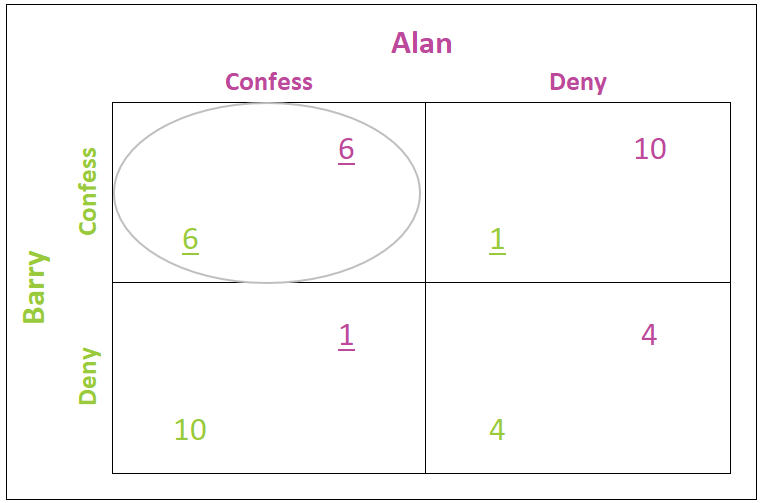Game Theory
View FREE Lessons!
Definition of Game Theory:
Game theory is a branch of mathematics that analyzes decision-making when a player’s outcome—and level of satisfaction—is influenced by decisions made by other players.
Detailed Explanation:
Many of the choices we make every day are influenced by the decisions made by others. Game theory helps us understand how decisions are made and can be used to identify the most likely result, which may or may not be the optimal decision. A game requires strategic reasoning and is played between two or more rational decision-makers. In any game, a player (whether an individual or a group) is trying to attain the highest payoff.
Game theory can be applied whenever outcomes or payoffs depend on choices by other participants. It has been used to understand the choices of players in economics, war, business, and psychology. For example, in war, game theory has been used to decide which supply route would incur the least damage from the enemy. Game theory has been used to analyze the threat of a nuclear war between North Korea and the United States. (Read
The Washington Post article published August 16, 2017.) Economists use game theory to explain the behavior of oligopolies, a business structure with only a few dominant companies. Game theory can help in evaluating how cooperative groups interact, such as when nations are working together for climate change.
In a game, the players must be identified. Players are decision-makers and can include individuals, organizations, or even governments. A game requires rational and strategic reasoning by each player. Strategic moves and the subsequent outcomes must be identified. Each outcome’s payoff depends on the decisions made by the players.
In a simultaneous game, two or more players pick their strategies at the same time, before knowing what the other player will do. That means players can only base their decisions on what they think the other player or players will do.
 Image from iStock
Image from iStock
Prisoner’s dilemma is the most common illustration of a simultaneous game and is applicable to many real-life scenarios. Suppose Alan and Barry committed two crimes. The police have enough evidence that they committed the first one, but not enough to convict them of the second crime. Obviously, Alan and Barry want to minimize their time in prison. In the classic prisoner’s dilemma example there are two criminals who are questioned by the police in separate rooms. The interrogator’s strategy is to get them to confess to the second crime by negotiating a plea bargain. Each prisoner is offered a lighter sentence if he confesses. Remember the prisoners are interrogated separately and do not know what the other will do, so they must independently decide whether to deny or confess to committing the crimes. The four possible outcomes are:
- Alan and Barry do not confess to the second crime.
- Alan and Barry confess to the second crime.
- Alan confesses, and Barry denies the second crime.
- Barry confesses, and Alan denies the second crime.
In our example, Alan and Barry would not be charged with the second crime if they both deny involvement in the second crime. Each would be sentenced to four years in prison for the first crime. Both would serve six years if they confess to committing the second crime. The third and fourth possibilities are very similar. In one case Alan confesses and Barry denies involvement, and in the other case Barry confesses and Alan denies involvement. In each scenario, the confessing individual would receive a one-year sentence, while the individual who stubbornly refuses to cooperate will serve ten years. How much do they trust their collaborator? Will either Alan or Barry try to reduce their sentence by confessing? The payoff table helps in understanding the possible outcomes and identifying each prisoner’s most probable decision. Figures representing Alan’s decisions are purple, and Barry’s decisions are green.

First, consider Alan's perspective. If Alan thinks Barry will confess, he will confess because he prefers six years in prison to ten. This is illustrated in the payoff matrix in the first row. The second row provides payoffs if Alan thinks Barry will deny involvement in the second crime, in which case he will also confess because being incarcerated for one year is better than four. No matter what Barry does, it is in Alan’s best interest to confess to committing the crime. Both of these outcomes are underlined in purple. This is called a dominant strategy. A dominant strategy is a strategy that always leads to the best payoff for a player, no matter what the other players do. A rational player will always play his dominant strategy. In this game, Alan’s dominant strategy is to confess.
Does Barry also have a dominant strategy? The columns provide Barry’s payoffs if he thinks Alan will confess and if he thinks Alan will deny. If Barry thinks Alan will confess, he should confess to reduce his sentence to six years from ten years. Barry should also confess if he thinks Alan will deny because that would reduce his sentence to only one year. Therefore, confessing is also Barry’s dominant strategy. These outcomes are underlined in green. Using the payoff table, we conclude that both criminals will always confess to the crime no matter what they believe their partner will do and each spends six years in prison. Economists refer to this as a Nash equilibrium. A Nash equilibrium outcome (NEO) is an expected outcome when no player can change his or her strategy to improve his or her payoff, assuming the other player’s decision stays the same. The Nash equilibrium is circled in the payoff matrix.
Why isn’t the most likely outcome where the criminals only spend four years in prison? After all, Alan and Barry would prefer being incarcerated for four years to serving six years. It is helpful to remember that both are acting independently. They do not know what the other person will do, so they both act in their own best interest. If either player thinks the other will deny committing the crime, the player should confess to committing the crime to pass the blame onto the player who denied it. In that case, the person who confessed only spends one year in prison, and the person who denies spends ten years in prison! It is never the best idea to deny, even if one prisoner believes the other convict will also deny. The prisoner’s dilemma demonstrates how without cooperation the best outcome can be hard to reach even when all the players behave rationally.
In contrast, people, businesses, and governments frequently respond to moves made by others. These “games” are not simultaneous. Economists refer to these games as sequential move games. In this type of game, one player makes the first decision and the second player responds. Chess is an example of a sequential game. Players respond in sequence to their opponent’s moves and try to anticipate their moves in advance. Decision trees help in understanding sequential move games. Sequential games can be continuous. For example, companies are always responding to changes in a competitor’s prices.
Dig Deeper With These Free Lessons:
Game Theory
Market Structures Part II – Monopolistic Competition and Oligopoly
Market Structures Part I – Perfect Competition and Monopoly

